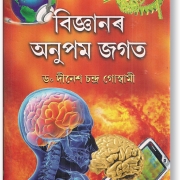
Etcetera

With a doctorate in physics, Dr Dinesh Chandra Goswami should have remained a mere scientist. Instead, his cosmic journey took him into the realm of the fantastic, from where he entertains anyone with an imaginative bone in their body. A physicist at the North East Institute of Science & Technology (erstwhile RRL) in Jorhat, Assam, the 68 year-old is a science fiction author with several Assamese novels, short stories, radio plays and articles to his name. “Science fiction tends to expand the mental horizon and vision of the reader in incomparable ways,” explains Goswami, whose characters include the New York Tiger who can walk through solid surfaces, or the mother who uses a brainwave manipulator to make her son concentrate on his studies. “A writer can take artistic liberty as long as the fiction does not violate the basic principles of science,” he says. Recipient of the Sahitya Akademi’s Bal Sahitya Puraskar in 2014 for his Bijnanor Anupam Jagat, a collection of essays for children, Goswami’s work attracts an adult audience too. He is currently working on his latest sci-fi story, set to be published in the September Durga Puja special issue of Mukuta, a popular Assamese children’s magazine, even as he puts together the second edition of Ashok Bijnan Abhidhan, a dictionary of science in Assamese.
What made you start writing?
When I was in school, my father subscribed to the Assamese weekly Asam Bani for me. It would come all the way to the remote village where I grew up. Its children’s page had children of all ages writing in, so I sent in some of my writing too. It was as an adult that I toyed with science fiction ideas. The first one—Kankal—published in 1970 was about a compact device that radiated directional electromagnetic rays, a skin-irritant that would compel the girls in a classroom to conceal their waist, which they would otherwise reveal as part of fashion. The protagonist was immediately punished for the use (or misuse) of the radiator, but subsequently rewarded for the invention.
How much of your work is rooted in real science?
A science fiction story is generally based on an extrapolated science concept—a scientific discovery or invention that is probable and follows scientific principles, but has not yet happened—and its impact on the characters of the story. The story always comes first but in science fiction, the story would not exist without that particular invention or discovery.
Why do you think sci-fi is a rare phenomenon among Indian writers?
Perhaps because writing science fiction is not easy. The writer has to be conversant with scientific concepts and thoroughly plan how to extrapolate the science without violating its basic principles. Then you build a story around this. Many writers are not willing to take this trouble. Others handle the job lightly; that’s when you end up writing fantasy.
You are currently tackling multiple writing projects. What is your process?
The Puja-special story is aimed at making children understand the value of science in daily life. This is the type of story that will develop as I keep writing it. I am also editing the second edition of Ashok Bijnan Abhidhan, which was first published in October 2016 and very well received. I have engaged a number of senior professors, doctors and engineers to formulate words and write their meanings. Some scientific terminology is available but a lot has to be been coined. It is a meticulous effort and rewarding experience. Now and then, I spend time compiling the third volume of my autobiography, which will also contain the stories behind some of my sci-fi writing. Long after my short-term projects are over, this book will keep me going.
—Dr Tapati Baruah Kashyap
Photo: Dr Tapati Baruah Kashyap Featured in Harmony — Celebrate Age Magazine August 2017
you may also like to read
-
Cracking the longevity code
Small yet impactful choices can be game-changers, writes Srirekha Pillai At 102, there’s no stopping Chandigarh-based Man Kaur, the world’s….
-
Home, not alone
While a regulatory framework is vital for senior-care facilities, the need of the hour is to develop an ecosystem to….
-
Birthday Girl
Published in a special edition to honour Japanese master storyteller Haruki Murakami’s 70th birthday, Birthday Girl (Penguin; Rs 100; 42….
-
A huge treat for music lovers
Published as the revised and updated second edition, Incomparable Sachin Dev Burman (Blue Pencil; Rs. 599; 470 pages) the authoritative….








